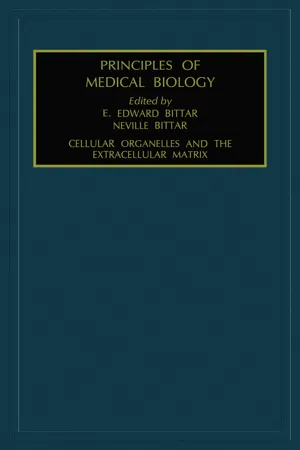
- 292 pages
- English
- PDF
- Available on iOS & Android
eBook - PDF
Cellular Organelles and the Extracellular Matrix
About this book
This volume is in two parts. The first contains the remaining chapters on cellular organelles and several chapters relating to organelle disorders. An account of mitochondriopathis is given in the chapter on the mitochondrion rather than in a separate one. The subject matter of this part of the volume shows quite clearly that the interdisciplinary approach to the study of organelles has shed considerable light on the nature of the mechanisms underlying the etiology and pathobiology of many of these disorders. As an example, mutations in the genes encoding integral membrane proteins are found to lead to disturbances in peroxisome assembly. It is also interesting and significant that mistargeting of protein is now thought to be another cause. It will be revealing to see whether mistargeting is the result of mutations in the genes encoding chaperones.The second part of the volume is concerned with the extracellular matrix. It sets out to show that a vast body of new knowledge of the extracellular matrix is available to us. Take for example the integrin family of cell adhesion receptors. It turns out that integrins play a key role not only in adhesion but also in coupling signals to the nucleus via the cytoskeleton. As for fibronectins, they seem to link the matrix with the cytoskeleton by interacting with integrins.Collagen molecules are dealt with in the last two chapters. The boundaries of collagen in disease are defined by drawing a clear line of demarcation between systemic connective tissue disorders (e.g., scleroderma), better known as autoimmune diseases, and the heritable, and the heritable diseases such as osteogenesis imperfect and the Marfan syndrome. This classification takes into account a second group of acquired disorders of collagen forming tissues in which regional fibrosis is the hallmark. Liver cirrhosis and pulmonary fibrosis are prime examples.The decision to place Volumes 2 and 3 before those dealing with cell chemistry was not easily made. It was based on the view that most students will have had an undergraduate course in biochemistry of cell biology or both courses, and that they could go to Volumes 4-7 in which the subject of cell chemistry is covered, and then return to Volumes 2 and 3.
Frequently asked questions
Yes, you can cancel anytime from the Subscription tab in your account settings on the Perlego website. Your subscription will stay active until the end of your current billing period. Learn how to cancel your subscription.
At the moment all of our mobile-responsive ePub books are available to download via the app. Most of our PDFs are also available to download and we're working on making the final remaining ones downloadable now. Learn more here.
Perlego offers two plans: Essential and Complete
- Essential is ideal for learners and professionals who enjoy exploring a wide range of subjects. Access the Essential Library with 800,000+ trusted titles and best-sellers across business, personal growth, and the humanities. Includes unlimited reading time and Standard Read Aloud voice.
- Complete: Perfect for advanced learners and researchers needing full, unrestricted access. Unlock 1.4M+ books across hundreds of subjects, including academic and specialized titles. The Complete Plan also includes advanced features like Premium Read Aloud and Research Assistant.
We are an online textbook subscription service, where you can get access to an entire online library for less than the price of a single book per month. With over 1 million books across 1000+ topics, we’ve got you covered! Learn more here.
Look out for the read-aloud symbol on your next book to see if you can listen to it. The read-aloud tool reads text aloud for you, highlighting the text as it is being read. You can pause it, speed it up and slow it down. Learn more here.
Yes! You can use the Perlego app on both iOS or Android devices to read anytime, anywhere — even offline. Perfect for commutes or when you’re on the go.
Please note we cannot support devices running on iOS 13 and Android 7 or earlier. Learn more about using the app.
Please note we cannot support devices running on iOS 13 and Android 7 or earlier. Learn more about using the app.
Yes, you can access Cellular Organelles and the Extracellular Matrix by Edward Bittar in PDF and/or ePUB format, as well as other popular books in Biological Sciences & Cell Biology. We have over one million books available in our catalogue for you to explore.
Information
Table of contents
- Front Cover
- Cellular Organelles and the Extracellular Matrix
- Copyright Page
- CONTENTS
- List of Contributors
- Preface
- Chapter 1. The Lysosome: Its Role in the Biology of the Cell and Organism
- Chapter 2. The Golgi Complex
- Chapter 3. The Peroxisome
- Chapter 4. The Mitochondrion
- Chapter 5. Lysosomal Storage Diseases
- Chapter 6. Peroxisomal Disorders
- Chapter 7. Molecules in Living Cells
- Chapter 8. Extracellular Matrix
- Chapter 9. Posttranslational Processing of Collagens
- Chapter 10. Cellular and Molecular Aspects of Selected Collagen Diseases
- Index